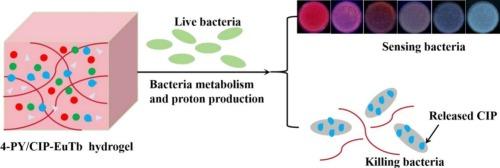用于视觉传感和细菌感染原位治疗的多色发光镧系金属水凝胶
IF 4.9
2区 化学
Q1 CHEMISTRY, ANALYTICAL
引用次数: 0
摘要
细菌感染的肉眼实时原位监测和根据细菌感染程度的按需给药系统的开发具有很高的吸引力,因为它们可以有效地避免抗生素的过度使用。本研究设计了一种基于氨基酸衍生物环丙沙星(CIP)和镧系离子(Tb3+/Eu3+)的智能发光水凝胶(4-PY/CIP- eutb)。该水凝胶可以发出多种颜色的光,包括4-PY/CIP发出蓝色光,Tb3+发出绿色光,Eu3+发出红色光,Tb3+和Eu3+的混合物发出白色光。4-PY/CIP-EuTb水凝胶的发光颜色可以通过调节发射波长或金属离子的比例来调节。值得注意的是,该金属水凝胶的发光颜色随pH值的变化而变化。在细菌生长和代谢过程中,会产生质子,改变细菌感染部位微环境的酸度。细菌生长引起的酸度增加会导致水凝胶中CIP与镧系离子的配位能力下降。因此,具有优异ph响应性的4-PY/CIP-EuTb水凝胶可用于视觉感知细菌感染。随着酸度的增加,水凝胶中的CIP可以逐渐释放出来,同时可以杀死细菌。因此,开发了一个实时监测细菌感染和原位杀死细菌的平台,作为临床诊断和治疗的宝贵辅助手段具有很大的前景。本文章由计算机程序翻译,如有差异,请以英文原文为准。

Lanthanide metallohydrogel with multicolor luminescence for visual sensing and in situ treatment of bacterial infections
The real-time in situ monitoring of bacterial infections with the naked eye and the development of an on-demand drug delivery system according to the degree of bacterial infection are highly attractive, as they can effectively avoid the overuse of antibiotics. In this study, a smart luminescent hydrogel (4-PY/CIP-EuTb) was designed based on an amino acid derivative, ciprofloxacin (CIP), and lanthanide ions (Tb3+/Eu3+). This hydrogel can emit multicolor luminescence including blue from 4-PY/CIP, green from Tb3+, red from Eu3+ and white from the mixture of Tb3+ and Eu3+, respectively. The luminescence color of the 4-PY/CIP-EuTb hydrogel can be modulated by adjusting the emission wavelength or the ratio of metal ions. Notably, the luminescence color of this metallohydrogel varies with the pH values. During bacterial growth and metabolism, protons are produced, altering the acidity of the microenvironment at the site of bacterial infection. The increased acidity caused by bacterial growth can trigger a decrease in the coordination ability between CIP and lanthanide ions in the hydrogel. Consequently, the 4-PY/CIP-EuTb hydrogel with excellent pH-responsiveness can be used to visually sense bacterial infection. As the acidity increases,CIP in the hydrogel can be gradually released, and it can simultaneously kill the bacteria. Thus, a platform for real-time monitoring of bacterial infection and in situ killing of bacteria has been developed, which holds great promise as a valuable aid in clinical diagnosis and treatment.
求助全文
通过发布文献求助,成功后即可免费获取论文全文。
去求助
来源期刊

Microchemical Journal
化学-分析化学
CiteScore
8.70
自引率
8.30%
发文量
1131
审稿时长
1.9 months
期刊介绍:
The Microchemical Journal is a peer reviewed journal devoted to all aspects and phases of analytical chemistry and chemical analysis. The Microchemical Journal publishes articles which are at the forefront of modern analytical chemistry and cover innovations in the techniques to the finest possible limits. This includes fundamental aspects, instrumentation, new developments, innovative and novel methods and applications including environmental and clinical field.
Traditional classical analytical methods such as spectrophotometry and titrimetry as well as established instrumentation methods such as flame and graphite furnace atomic absorption spectrometry, gas chromatography, and modified glassy or carbon electrode electrochemical methods will be considered, provided they show significant improvements and novelty compared to the established methods.
 求助内容:
求助内容: 应助结果提醒方式:
应助结果提醒方式:


